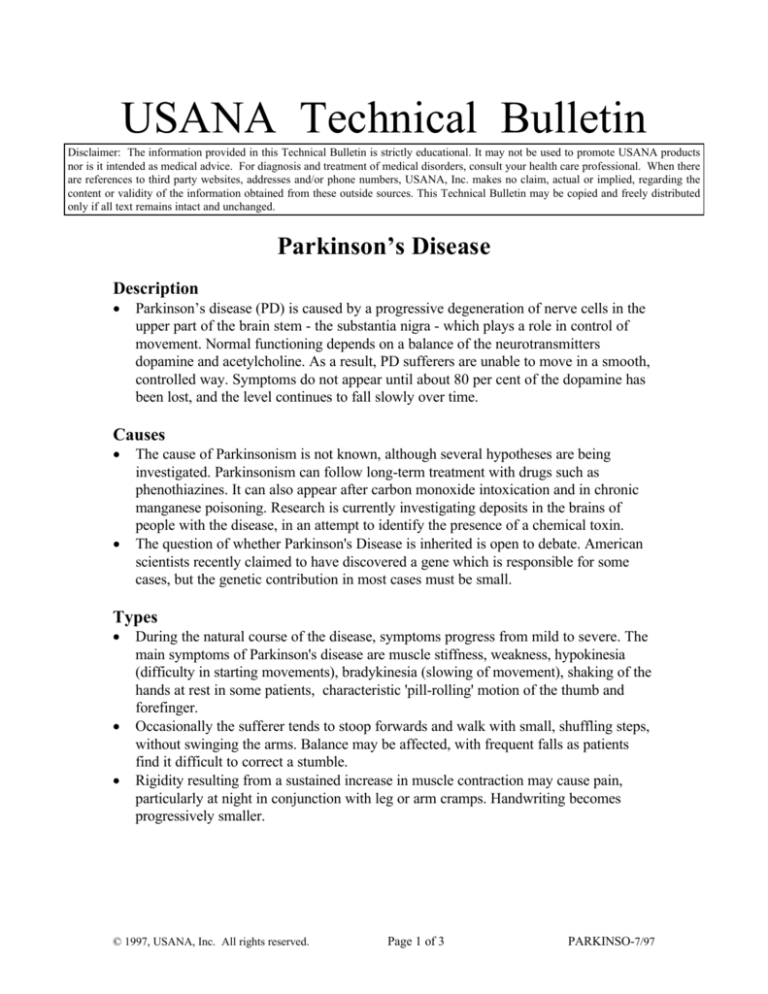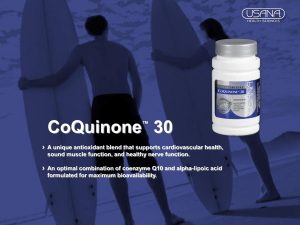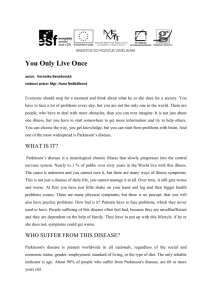
USANA Technical Bulletin
Disclaimer: The information provided in this Technical Bulletin is strictly educational. It may not be used to promote USANA products
nor is it intended as medical advice. For diagnosis and treatment of medical disorders, consult your health care professional. When there
are references to third party websites, addresses and/or phone numbers, USANA, Inc. makes no claim, actual or implied, regarding the
content or validity of the information obtained from these outside sources. This Technical Bulletin may be copied and freely distributed
only if all text remains intact and unchanged.
Parkinson’s Disease
Description
•
Parkinson’s disease (PD) is caused by a progressive degeneration of nerve cells in the
upper part of the brain stem - the substantia nigra - which plays a role in control of
movement. Normal functioning depends on a balance of the neurotransmitters
dopamine and acetylcholine. As a result, PD sufferers are unable to move in a smooth,
controlled way. Symptoms do not appear until about 80 per cent of the dopamine has
been lost, and the level continues to fall slowly over time.
Causes
•
•
The cause of Parkinsonism is not known, although several hypotheses are being
investigated. Parkinsonism can follow long-term treatment with drugs such as
phenothiazines. It can also appear after carbon monoxide intoxication and in chronic
manganese poisoning. Research is currently investigating deposits in the brains of
people with the disease, in an attempt to identify the presence of a chemical toxin.
The question of whether Parkinson's Disease is inherited is open to debate. American
scientists recently claimed to have discovered a gene which is responsible for some
cases, but the genetic contribution in most cases must be small.
Types
•
•
•
During the natural course of the disease, symptoms progress from mild to severe. The
main symptoms of Parkinson's disease are muscle stiffness, weakness, hypokinesia
(difficulty in starting movements), bradykinesia (slowing of movement), shaking of the
hands at rest in some patients, characteristic 'pill-rolling' motion of the thumb and
forefinger.
Occasionally the sufferer tends to stoop forwards and walk with small, shuffling steps,
without swinging the arms. Balance may be affected, with frequent falls as patients
find it difficult to correct a stumble.
Rigidity resulting from a sustained increase in muscle contraction may cause pain,
particularly at night in conjunction with leg or arm cramps. Handwriting becomes
progressively smaller.
© 1997, USANA, Inc. All rights reserved.
Page 1 of 3
PARKINSO-7/97
At Risk
•
Parkinson's disease affects one in every 1,000 of the general population, increasing to
one in 100 of those aged over 65. Although it is usually regarded as a disease of the
elderly, one in every seven sufferers is diagnosed under the age of 40.
Prevention and Management
•
•
•
•
Because dopamine is depleted, there is a relative excess of acetylcholine. The main aim
of drug treatment is to restore the balance between acetylcholine and dopamine.1
Treatment must be tailored to the individual and timing can be as important as the
dosage.2
Patients should be encouraged to keep as active as possible and to look for other
hobbies to replace those they can no longer do. The most beneficial activity is regular
walking. Physiotherapists may recommend exercises to help mobility. Speech therapy
can help communication in later stages of the disease.
Oxidative stress is thought to play a role in the etiology of Parkinson’s.3,4 However,
there is no firm evidence as yet that the antioxidant vitamins A,C and E slow the
disease's progress, although such treatment might be justifiable in theory.5,6
Vitamin B6 antagonizes levodopa unless given with a dopa-decarboxylase inhibitor.
Iron may also reduce levodopa absorption.
Abstracts
Burkhardt CR, Weber HK. Parkinson's disease: a chronic, low-grade antioxidant
deficiency? Med Hypotheses 1994 Aug;43(2):111-4. The cause of Parkinson's disease (PD) is
aggressively being pursued. Several hypotheses have been advanced, yet none of these completely explains
the large body of evidence research has already uncovered. A new hypothesis, that PD is caused by a
chronic antioxidant deficiency state, is outlined in this article. Oxidative stress, mitochondrial
abnormalities, epidemiology, genetics, toxins, history of PD and diet are discussed.
Jenner P. Oxidative stress in Parkinson's disease and other neurodegenerative
disorders. Pathol Biol (Paris) 1996 Jan;44(1):57-64. The cause of cell death in
neurodegenerative diseases remains unknown but the formation of free radicals and the occurrence of
oxidative stress may be a common component of many, if not all, such disorders. For example, in
substantia nigra in Parkinson's diseases key alterations occur, in iron handling, mitochondrial function
and antioxidant defences, particularly reduced glutathione. These indices of oxidative stress are
accompanied by evidence of free radical mediated damage in the form of increased lipid peroxidation and
oxidation of DNA bases. The alterations in oxidative stress occurring in Parkinson's disease appear not be
related to the administration of L-DOPA. Some alterations of oxidative stress are found in other basal
ganglia in degenerative disorders (multiple system atrophy, progressive supranuclear palsy, Huntington's
disease) but these have not been investigated to the same extent. Similarly, examination of biochemical
changes occurring in Alzheimer's disease, motor neurone disease and diabetic neuropathy also suggest the
involvement of free radical mediated mechanisms as a component of neurodegeneration. It is probable
that irrespective of the primary cause of individual neurodegenerative disorder, the onset of oxidative
stress is a common mechanism by which neuronal death occurs and which contributes to disease
progression. Clearly, therapeutic strategies aimed at limiting free radical production and oxidative stress
and/or damage may slow the advance of neurodegenerative disease.
© 1997, USANA, Inc. All rights reserved.
Page 2 of 3
PARKINSO-7/97
References
1
Aminoff MJ. Treatment of Parkinson's disease. West J Med 1994 Sep;161(3):303-8
Olanow CW. Deprenyl in the treatment of Parkinson's disease: clinical effects and speculations on
mechanism of action. J Neural Transm Suppl 1996;48:75-84
3
Jenner P and Olanow CW. Oxidative stress and the pathogenesis of Parkinson's disease. Neurology 1996
Dec;47(6 Suppl 3):S161-70
4
Bowling AC and Beal MF. Bioenergetic and oxidative stress in neurodegenerative diseases. Life Sci
1995;56(14):1151-71
5
Ebadi M, Srinivasan SK and Baxi MD. Oxidative stress and antioxidant therapy in Parkinson's disease.
Prog Neurobiol 1996 Jan;48(1):1-19
6
Wu RM, Mohanakumar KP, Murphy DL and Chiueh CC. Antioxidant mechanism and protection of
nigral neurons against MPP+ toxicity by deprenyl (selegiline). Ann N Y Acad Sci 1994 Nov 17;738:21421
2
© 1997, USANA, Inc. All rights reserved.
Page 3 of 3
PARKINSO-7/97








